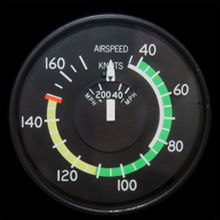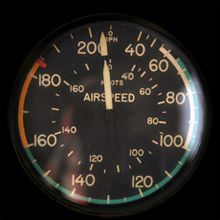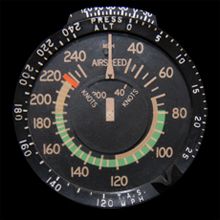Maneuvering Speed
Maneuvering speed, Va, is defined (either normal or utility) as the maximum speed the airplane can fly and be able to stall before any structural damage occurs on the wings from excessive loads. It almost seems like a speed set for the airplane, like an amp limit for a breaker in an electrical circuit, before you blow a wire (or a wing in this case).
Pilot’s Handbook of Aeronautical Knowledge
The maximum speed at which an airplane may be stalled safely is now determined for all new designs. This speed is called the “design maneuvering speed” (VA), which is the speed below which you can move a single flight control, one time, to its full deflection, for one axis of airplane rotation only (pitch, roll or yaw), in smooth air, without risk of damage to the airplane.
VA must be entered in the FAA-approved Airplane Flight Manual/ Pilot’s Operating Handbook (AFM/POH) of all recently designed airplanes. For older general aviation airplanes, this speed is approximately 1.7 times the normal stalling speed. Thus, an older airplane that normally stalls at 60 knots must never be stalled at above 102 knots (60 knots × 1.7 = 102 knots). An airplane with a normal stalling speed of 60 knots stalled at 102 knots undergoes a load factor equal to the square of the increase in speed, or 2.89 Gs (1.7 × 1.7 = 2.89 Gs). (The above figures are approximations to be considered as a guide, and are not the exact answers to any set of problems. The design maneuvering speed should be determined from the particular airplane’s operating limitations provided by the manufacturer.)
Operating at or below design maneuvering speed does not provide structural protection against multiple full control inputs in one axis or full control inputs in more than one axis at the same time.
All standard certificated aircraft are designed to withstand loads imposed by gusts of considerable intensity. Gust load factors increase with increasing airspeed, and the strength used for design purposes usually corresponds to the highest level flight speed. In extremely rough air, as in thunderstorms or frontal conditions, it is wise to reduce the speed to the design maneuvering speed. Regardless of the speed held, there may be gusts that can produce loads that exceed the load limits.
Each specific aircraft is designed with a specific G loading that can be imposed on the aircraft without causing structural damage. There are two types of load factors factored into aircraft design: limit load and ultimate load. The limit load is a force applied to an aircraft that causes a bending of the aircraft structure that does not return to the original shape. The ultimate load is the load factor applied to the aircraft beyond the limit load and at which point the aircraft material experiences structural failure (breakage). Load factors lower than the limit load can be sustained without compromising the integrity of the aircraft structure.
Speeds up to, but not exceeding, the maneuvering speed allow an aircraft to stall prior to experiencing an increase in load factor that would exceed the limit load of the aircraft.
TL;DR
As Sparky Imeson said, When operating at a speed greater than maneuvering speed vertical gusts can cause a sudden increase in the angle of attack. This results in large wing loads that are resisted by the inertia of the airplane. The structure is not designed to withstand this load and may become permanently deformed or worse, it may fail. When operating at or less than maneuver speed, the airplane will stall before breaking. Gusts are momentary features, so the stall is a brief stall and normally does not require pilot-initiated stall recovery.
Rule of Thumb
One of my instructors pointed out to me that on every airplane that he has flown, the maneuvering speed was around the 6:00 position on the Airspeed Indicator. While that doesn’t substitute for knowing the speed, it’s better than flying through turbulence at a speed much greater than the wings can support.

Cessna 152 Airspeed Indicator

Cessna 182 Airspeed Indicator

Cessna T210 Airspeed Indicator
Cessna 152’s maneuvering speed is a range of 93 to 104 knots, the Cessna 182 is 128 MPH, and the Cessna 210 is 135 MPH at max gross.
Lessons Learned
Following the crash of American Airlines Flight 587 the FAA issued Advisory Circular AC 25.1581-1. In it they advise that:
1 Full application of pitch, roll, and/or yaw controls should be confined to speeds below the maneuvering speed; and
2 Rapid and large alternating control inputs, especially in combination with large changes in pitch, roll, or yaw, and full control inputs in more than one axis at the same time should be avoided as they may result in structural failures at any speed, including below the maneuvering speed.
AC 61-67C Stall and Spin Awareness
f. VA. VA is the design maneuvering speed. Do not use full or abrupt control movements at or above this speed. It is possible to exceed the airplane structural limits at or above VA.
g. Load Factor. Load factor is the ratio of the lifting force produced by the wings to the actual weight of the airplane and its contents. Load factors are usually expressed in terms of “G.” The aircraft’s stall speed increases in proportion to the square root of the load factor. For example, an airplane that has a normal unaccelerated stall speed of 45 knots can be stalled at 90 knots when subjected to a load factor of 4 G’s. The possibility of inadvertently stalling the airplane by increasing the load factor (i.e., by putting the airplane in a steep turn or spiral) is much greater than in normal cruise flight. A stall entered from straight and level flight or from an unaccelerated straight climb will not produce additional load factors. In a constant rate turn, increased load factors will cause an airplane’s stall speed to increase as the angle of bank increases. Excessively steep banks should be avoided because the airplane will stall at a much higher speed. If the aircraft exceeds maneuvering speed, structural damage to the aircraft may result before it stalls. If the nose falls during a steep turn, the pilot might attempt to raise it to the level flight attitude without shallowing the bank. This situation tightens the turn and can lead to a diving spiral. A feeling of weightlessness will result if a stall recovery is performed by abruptly pushing the elevator control forward, which will reduce the up load on the wings. Recoveries from stalls and spins involve a tradeoff between loss of altitude (and an increase in airspeed) and an increase in load factor in the pullup. However, recovery from the dive following spin recovery generally causes higher airspeeds and consequently higher load factors than stall recoveries due to the much lower position of the nose. Significant load factor increases are sometimes induced during pullup after recovery from a stall or spin. It should be noted that structural damage can result from the high load factors that could be imposed on the aircraft by intentional stalls practiced above the airplane’s design maneuvering speed.
l. Turbulence. Turbulence can cause an aircraft to stall at a significantly higher airspeed than in stable conditions. A vertical gust or windshear can cause a sudden change in the relative wind, and result in an abrupt increase in AOA. Although a gust may not be maintained long enough for a stall to develop, the aircraft may stall while the pilot is attempting to control the flightpath, particularly during an approach in gusty conditions. When flying in moderate to severe turbulence or strong crosswinds, a higher than normal approach speed should be maintained. In cruise flight in moderate or severe turbulence, an airspeed well above the indicated stall speed and below maneuvering speed should be used. It should be noted that maneuvering speed is lower at a lower weight.
Calculating Maneuvering Speed with Different Weights
The formula used to calculate a safe speed for a lower weight is Va * Sqrt(W1/W2), where Va maneuvering speed (at maximum weight), W2 = actual airplane weight, W1 = maximum weight.
From the forumula we see that the maximum Va is at maximum weight.
This is the javascript code I use in calculating Va for various weights:
var Calculated_Va = Va_at_maxweight * Math.sqrt(Total_Weight/Gross_Weight_max);
var Calculated_Va_MPH = Calculated_Va * 1.15;Technical Details
This article Maneuvering Loads, High-G Maneuvers give some of the technical details behind the calculation of maneuvering speed.


